neutral to beneficial; presumably feeds on decomposing organic matter and/or associated fungi in bee nests
Thyreophagus Rondani, 1874
Superorder Acariformes » Order Sarcoptiformes » Suborder Oribatida » Infraorder Desmonomata » Hyporder Astigmata » Family Acaridae » Genus Thyreophagus
"Thyreophagus entomophagus Laboulb." (=Acarus entomophagus Laboulbène, 1852 (nom. nud.), Tyroglyphus entomophagus Laboulbène and Robin, 1862, Thyreophagus entomophagus (Laboulbène and Robin, 1862))
Fumouzea Zachvatkin, 1953, Michaelopus Fain and Johnston, 1974, Monieziella Berlese, 1897 (=Moniziella Berlese, 1897 variant spelling).
Thyreophagus flour mite
Phoretic phoretic:
Pertaining to phoresy; using another organism (i.e., a host) for dispersal to new habitats. Phoresy can be distinguished from parasitism because feeding typically does not occur during phoresy.
deutonymph: Eyes present, widely separated, represented by pigmented eyespots (retinae) and distinct lenses (Fig. 3).
Phoretic phoretic:
Pertaining to phoresy; using another organism (i.e., a host) for dispersal to new habitats. Phoresy can be distinguished from parasitism because feeding typically does not occur during phoresy.
deutonymph: Tarsal setae aa I absent. Setae ba I absent, ba II present (not correlated with adults). Setae ve absent (can be topologically misinterpreted as se). Coxal apodemesapodeme:
Internal sclerite that serves as an attachment site for muscles. Most commonly used (as "coxal apodeme") to describe elements of coxae fused to the ventral body in Acariformes (coxae are free and not fused to the body in Parasitiformes), and may be variously referred to as ventral, sternal, anterior, or posterior.
 III-IV ending freely, not closed (Fig. 4). “Saucer” at the end of tarsal setae e I-II present. Genugenu:
III-IV ending freely, not closed (Fig. 4). “Saucer” at the end of tarsal setae e I-II present. Genugenu:
Leg or palp segment (also known as podomere or palpomere) between tibia and femur.
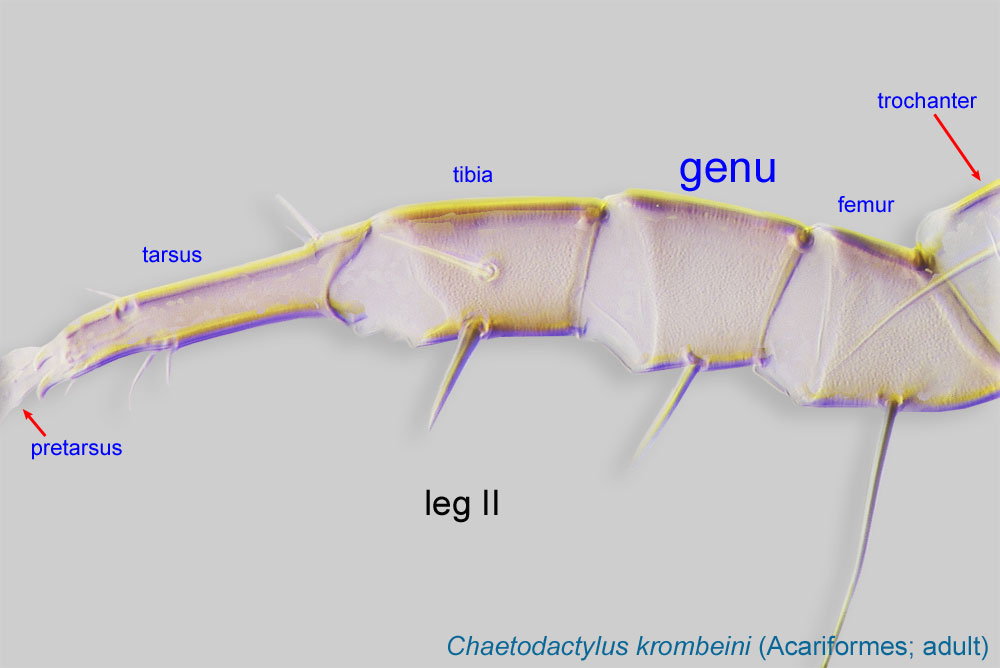 I with one solenidionsolenidion:
I with one solenidionsolenidion:
Thin-walled, terminally rounded or pointed filiform or peglike structure that is not birefringent in polarized light (unlike common setae in Acariformes). Often appears striated because of its internal structure. Found on the palpal tarsus on the gnathosoma and may also occur on the tarsus and tibia, less frequently on the genu, and occasionally on the femur of legs I-IV. In Acariformes, leg solenidia often arise from unsclerotized areas.
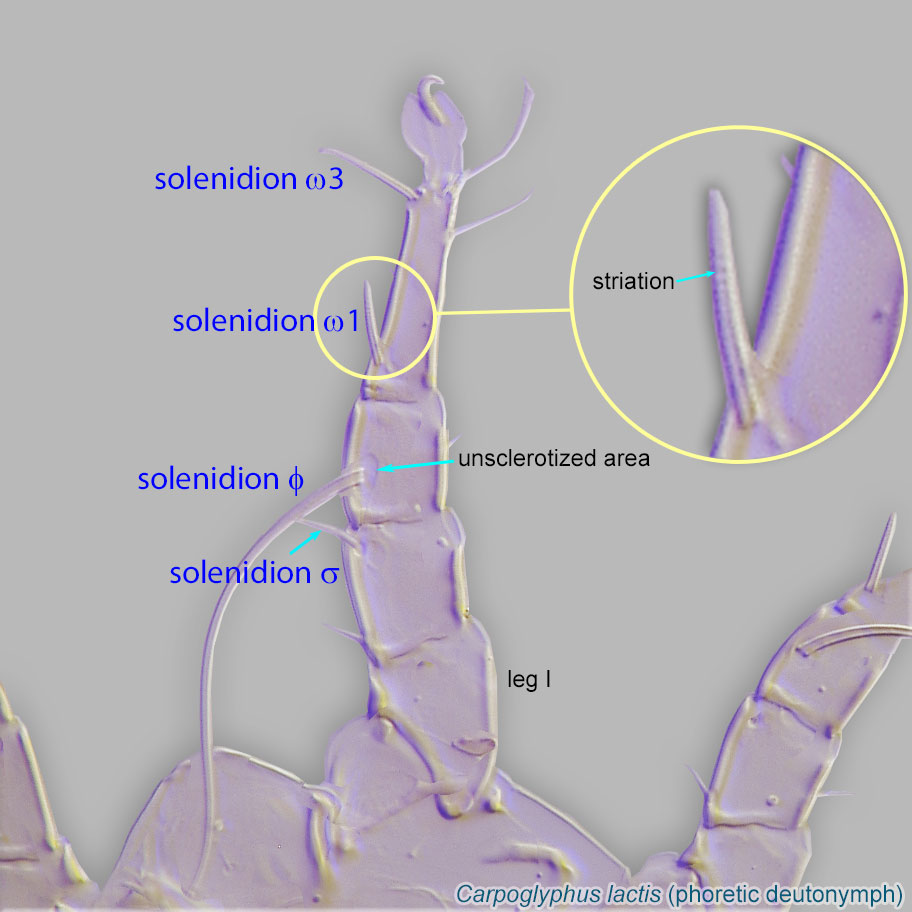 (σ). External conoidal setae (ps2) of attachment organattachment organ:
(σ). External conoidal setae (ps2) of attachment organattachment organ:
Complex unpaired structure in phoretic deutonymphs of Astigmata situated on the posteroventral end of the body that serves for attachment to the host during phoresy. In deutonymphs phoretic on insects, attachment organ consists of a vestigial anal opening and two types of attachment elements: true suckers that create negative pressure and conoids that create adhesive forces. Not to be confused with pedicel.
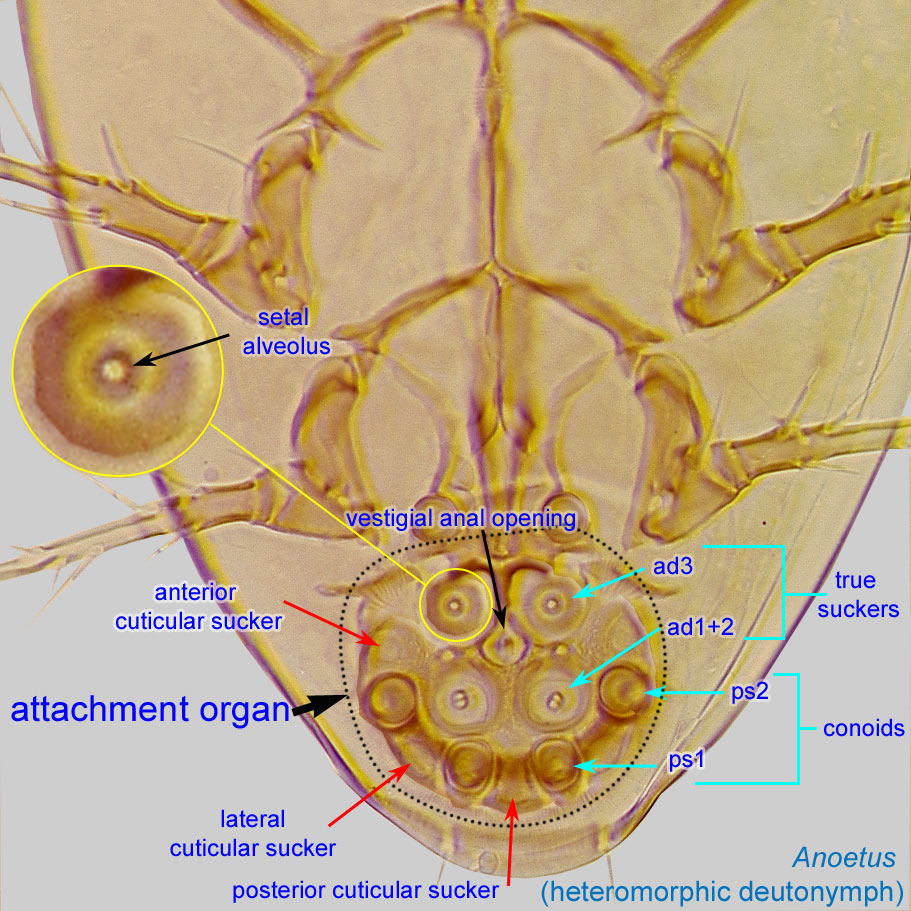 slightly posterior to median suckers (ad1+2) (Fig. 4). Solenidionsolenidion:
slightly posterior to median suckers (ad1+2) (Fig. 4). Solenidionsolenidion:
Thin-walled, terminally rounded or pointed filiform or peglike structure that is not birefringent in polarized light (unlike common setae in Acariformes). Often appears striated because of its internal structure. Found on the palpal tarsus on the gnathosoma and may also occur on the tarsus and tibia, less frequently on the genu, and occasionally on the femur of legs I-IV. In Acariformes, leg solenidia often arise from unsclerotized areas.
 σ III and setae nG III absent. Coxal setae 1a, 3a minute, filiform, 4a conoidal.
σ III and setae nG III absent. Coxal setae 1a, 3a minute, filiform, 4a conoidal.
Adult: Body elongated (Figs. 5, 6). External vertical setae (ve) represented by alveoli, located on lateral sides of prodorsalprodorsal:
Pertaining to the prodorsum.
shield, approximately midway between vi and scapular setae se (Fig. 7). Setae ba I-II absent, famulus (in Astigmata, a small, hollow, and optically active seta- or spine-like structure located just distally to solenidionsolenidion:
Thin-walled, terminally rounded or pointed filiform or peglike structure that is not birefringent in polarized light (unlike common setae in Acariformes). Often appears striated because of its internal structure. Found on the palpal tarsus on the gnathosoma and may also occur on the tarsus and tibia, less frequently on the genu, and occasionally on the femur of legs I-IV. In Acariformes, leg solenidia often arise from unsclerotized areas.
 ω1 on tarsustarsus:
ω1 on tarsustarsus:
Terminal segment (also known as podomere or palpomere) of legs or palps. In Parasitoformes it can be subdivided into telotarsus and basitarsus.
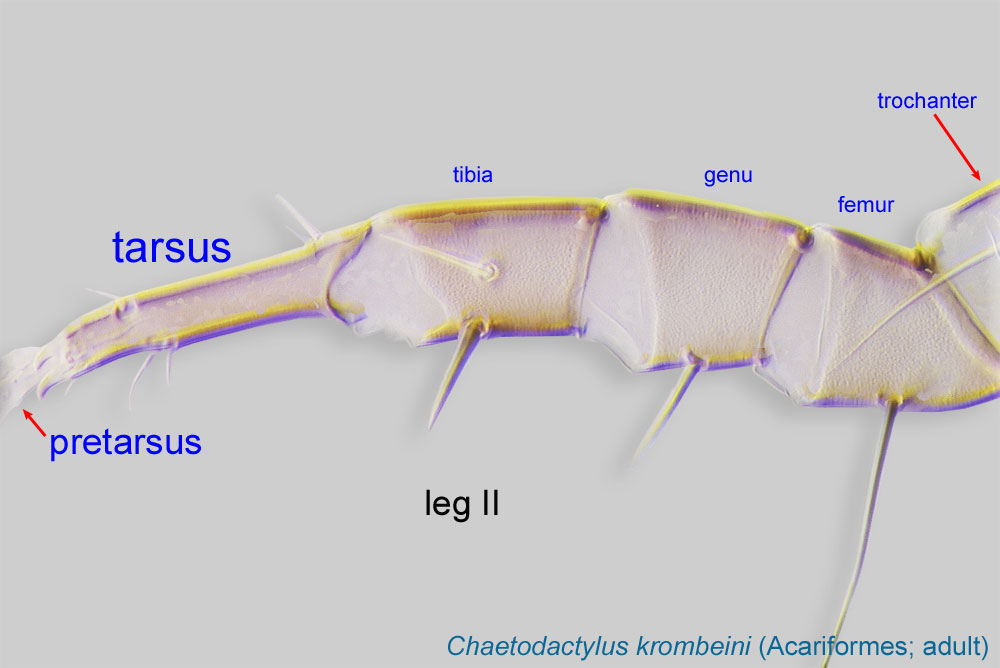 I) present, enlarged, spiniform (alternatively famulus can be interpreted as ba I) (Fig. 11). Hysterosomal setae c1, c2, and d1 absent; setae f2 absent (Fig. 8). Male with sclerotized projection extending from posterior opisthosomaopisthosoma:
I) present, enlarged, spiniform (alternatively famulus can be interpreted as ba I) (Fig. 11). Hysterosomal setae c1, c2, and d1 absent; setae f2 absent (Fig. 8). Male with sclerotized projection extending from posterior opisthosomaopisthosoma:
Body division posterior to legs IV; usually there is no distinct boundary delimiting this part of idiosoma.
(Fig. 9). Projection is broad, with seta h1. In male, bases of setae h2, h3 and ps1 arranged in a triangle on ventral surface of posterior sclerotized projection (Fig. 10).
Keys to species of both adults and phoreticphoretic:
Pertaining to phoresy; using another organism (i.e., a host) for dispersal to new habitats. Phoresy can be distinguished from parasitism because feeding typically does not occur during phoresy.
deutonymphsdeutonymph:
Ontogenetic stage between protonymph and tritonymph (or adult, if tritonymph is absent). See <a href="index.cfm?pageID=1720">Life stages page</a> for more details.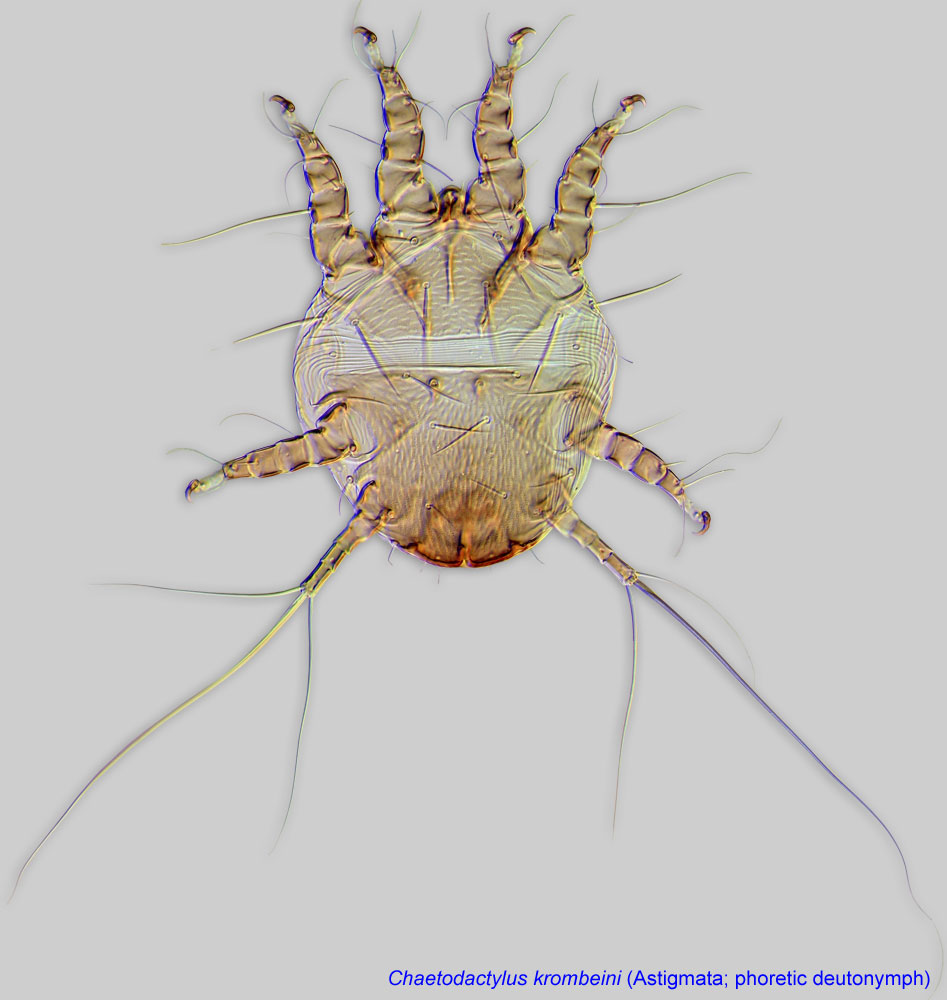 are available in Fain, 1982Fain, 1982:
are available in Fain, 1982Fain, 1982:
Fain, A. 1982. Revision des genres Thyreophagus Rondani, 1874 et Michaelopus Fain amp; Johnston, 1974 (Acari, Acaridae) avec description de neuf especes nouvelles. Bulletin de l'Institut Royal des Sciences Naturelles de Belgique Entomologie . 54 : 1-47. and Barbosa et al., 2016Barbosa et al., 2016:
Barbosa, M. F. de C., B. M. OConnor amp; G. J. de Moraes. 2016. A new species of Thyreophagus (Acari: Acaridae) from Brazil, with notes on species associated with stored food and human habitats and a key to species of this genus. Zootaxa 4088: 279-291.. The phoreticphoretic:
Pertaining to phoresy; using another organism (i.e., a host) for dispersal to new habitats. Phoresy can be distinguished from parasitism because feeding typically does not occur during phoresy.
deutonymphdeutonymph:
Ontogenetic stage between protonymph and tritonymph (or adult, if tritonymph is absent). See <a href="index.cfm?pageID=1720">Life stages page</a> for more details. of Thyreophagus entomophagus (not included in Fain, 1982Fain, 1982:
of Thyreophagus entomophagus (not included in Fain, 1982Fain, 1982:
Fain, A. 1982. Revision des genres Thyreophagus Rondani, 1874 et Michaelopus Fain amp; Johnston, 1974 (Acari, Acaridae) avec description de neuf especes nouvelles. Bulletin de l'Institut Royal des Sciences Naturelles de Belgique Entomologie . 54 : 1-47.) is described in Fain et al., 2000Fain et al., 2000:
Fain, A., W. Knuelle amp; E. Wurst. 2000. First description of the hypopial stage of Thyreophagus entomophagus (Laboulbene, 1852) (Acari Acaridae). Bulletin de la Societe Royale Belge d'Entomologie . 136 : 153-156..
Worldwide; has been found in association with bees in the Palaearctic (Apis mellifera) and Neotropics (stingless bees).
European honey bee (Apis mellifera) hives and stingless bee (Meliponini) nests
facultativefacultative:
can complete entire life cycle without bees or their close relative, wasps
 are not known from bees but are known from other insects. Dispersal of feeding stages is known on rodents, but this may be an accidental record.
are not known from bees but are known from other insects. Dispersal of feeding stages is known on rodents, but this may be an accidental record.Among bee hosts, three generalist species of Thyreophagus have been found in debris from beehives of Apis: Thyreophagus corticalis, Thyreophagus entomophagus, and Thyreophagus odyneri. Under laboratory conditions, these species prefer bee bread, pollen, bee hive debris, and mold; Th. entomophagus has also been observed feeding and reproducing on dead brood bees, and the two other species on wax and combs; no reproduction has occurred on honey, royal jelly, or propolispropolis:
A red or brown resinous substance collected by honey bees from tree buds that is used by them to fill crevices and to seal and varnish honeycombs.
for either species (Chmielewski, 1991cChmielewski, 1991c:
Chmielewski, W. 1991c. Stored products mites (Acaroidea) in Polish bee hives. In Modern acarology. Volume I: proceedings of the 8 International Congress of Acarology, held in Ceske Budejovice, Czechoslovakia, 6-11 August 1990. , 615-619. The Hague, The Netherlands: SPB Academic Publishing.).
Feeding stages of Th. entomophagus have also been found on a museum specimen of the bumble bee Bombus lapidarius. A species of Thyreophagus was found in moldy nest material of stingless bees in the Neotropics (our data, Fig. 13).
Species of this genus inhabit different habitats and as phoreticphoretic:
Pertaining to phoresy; using another organism (i.e., a host) for dispersal to new habitats. Phoresy can be distinguished from parasitism because feeding typically does not occur during phoresy.
deutonymphsdeutonymph:
Ontogenetic stage between protonymph and tritonymph (or adult, if tritonymph is absent). See <a href="index.cfm?pageID=1720">Life stages page</a> for more details. use a large array of animals for dispersal: collembolans, beetles, ichneumonids, ants, fleas, birds, and mammals. Adults and other feeding stages are found in decomposing plant material, forest litter, soil, stored food including flour, sporocarps of bracket fungi, flowers, house dust, nests of birds, or on rodents themselves. Some species are associated with scale insects (Diaspididae) and were suggested to be "parasitic." Thyreophagus entomophagus attacks entomological collections and can be found on insect museum specimens. It is not always clear whether the occurence of this mite results from deutonymphsdeutonymph:
use a large array of animals for dispersal: collembolans, beetles, ichneumonids, ants, fleas, birds, and mammals. Adults and other feeding stages are found in decomposing plant material, forest litter, soil, stored food including flour, sporocarps of bracket fungi, flowers, house dust, nests of birds, or on rodents themselves. Some species are associated with scale insects (Diaspididae) and were suggested to be "parasitic." Thyreophagus entomophagus attacks entomological collections and can be found on insect museum specimens. It is not always clear whether the occurence of this mite results from deutonymphsdeutonymph:
Ontogenetic stage between protonymph and tritonymph (or adult, if tritonymph is absent). See <a href="index.cfm?pageID=1720">Life stages page</a> for more details. that molt on the same hosts and subsequently establish a colony or because of mites that spread from different insect specimens stored in museums.
that molt on the same hosts and subsequently establish a colony or because of mites that spread from different insect specimens stored in museums.